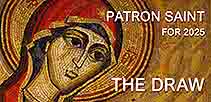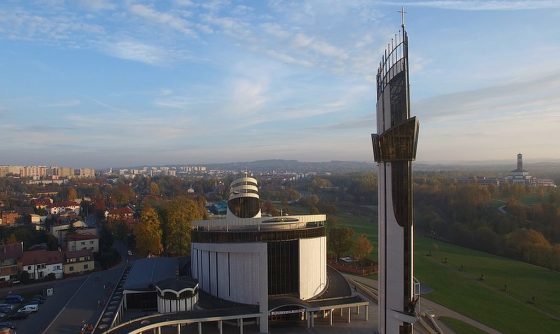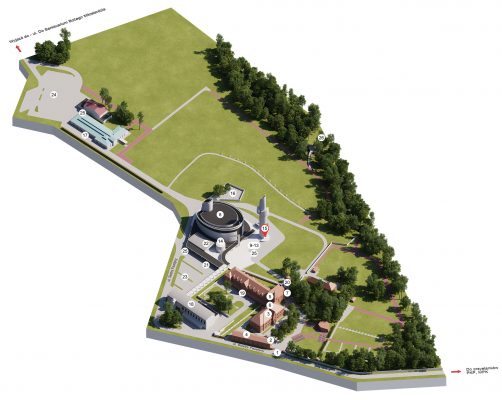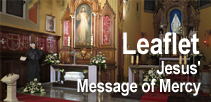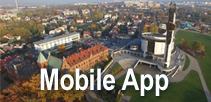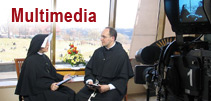We have put a map of the Shrine after the text.
In front of the Basilica there is a free-standing viewing tower which is 77 metres tall and is a landmark which can be seen from many places in the city, like a lighthouse guiding people from all over the world to a safe port where they can meet the living God and through the mystical experience of St. Faustina discover and develop a deeper understanding of His merciful love for them. In a world full of unrest and existential menace, here they can hear the words of Jesus recorded in Sister Faustina’s Diary: “My mercy is greater than your wretchedness and all the world’s wretchedness. Who has measured My goodness? For you I came down to Earth from Heaven; for you I let Myself be nailed to the cross; for you I let the lance pierce My Most Sacred Heart and I opened up the spring of mercy for you; come and draw graces from this spring with the vessel of trust. I shall never reject a humble heart;” (Diary 1485).
The tower is fitted out with a viewing platform which offers a splendid panorama of Kraków and its environs. In the right visibility conditions, you can even see the Tatra Mountains. A staircase of 315 steps leads up to the platform, but there is also a lift which disabled persons can use. Over the entrance to the tower there is a statue of Pope John Paul II as a pilgrim of peace holding a dove and bringing the message of Mercy to the world, almost as if he were repeating the words of Jesus, “Mankind shall not find peace and contentment until it turns with trust unto My mercy” (Diary 300), or recalling his own words spoken in this Shrine, “There is nothing mankind needs as much as Divine mercy, that gracious love which is full of empathy and which raises Man up from his weakness, towards the infinite heights of God’s holiness. Here in this place we realise that in a special way,” because it was from here that Jesus gave His message of Mercy to the Church and the world through the services of St. Faustina. The statue of the Pope, by Witold Cęckiewicz, was unveiled in 2006, on the day of the pilgrimage of his successor, Pope Benedict XVI, to the Łagiewniki Shrine.
The Basilica is surrounded by meadows and fields where once Sister Faustina worked in the convent’s garden and greenhouses. Today the area is the site of the Stations of the Cross where crowds of pilgrims come to pray in the open air, especially on the Feast of Mercy and other important events in the Shrine. South of the fields, a footbridge known as the Bridge of Mercy (Most Miłosierdzia) crosses over the River Wilga and a tunnel known as the Łagiewniki Route (Trasa łagiewnicka), and leads up to the Shrine of St. John Paul II (Sanktuarium św. Jana Pawła II).
In front of the basilica there is a set of 9 bells which play carillons in honour of Divine mercy. The names of the bells are Jesus, Sister Faustina, John Paul II, and the remaining six have been named after other Cracovian Saints (St. Stanislaus, St. Jacek, St. Jadwiga, St. John Cantius, St. Rafał, and St. Albert). Each bell has its name inscribed on it; each has its own sound and they are all in perfect harmony, playing hymns selected to suit the season of the liturgical year. The largest bell, called St. John the Baptist, which was founded by Bishop Jan Zając in 2011 for the beatification of John Paul II, is next to the Basilica and produces its fine, sonorous sound to mark the most important ceremonies.
- Main entrance to the Shrine
- Sister Faustina’s House: hotel & museum
- Convent
- Antoninek House: Faustinum Association
-
Merciful Jesus Chapel & Saint Faustina’s Tomb: Heart of the Shrine
- Oratory: room where Saint Faustina died
- Chapel of the Lord’s Passion
- Divine Mercy Basilica
- Saint Faustina’s Chapel
- The Communio Sanctorum Chapel
- Saint Andrew’s Chapel
- The Holy Cross Chapel
- The Chapel of Our Lady of the Seven Sorrows
- Perpetual Adoration Chapel
- Viewing Tower
- Convent Graveyard
- Sister Faustina’s House: restaurant, souvenirs & meeting hall
- Pastoral Lodge: hotel & restaurant
- Mercy House
- Information Booth
- Souvenirs & Misericordia Bookshop
- Saint John Paul II Hall
- Car park
- Car and coach park
- Toilets
- Bridge of Mercy, for the Saint John Paul II Shrine & tram stop










